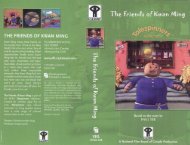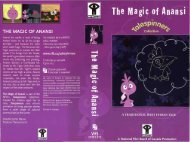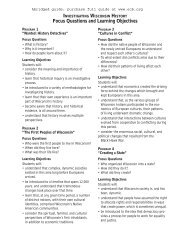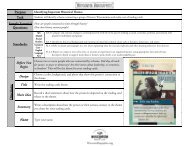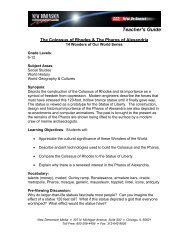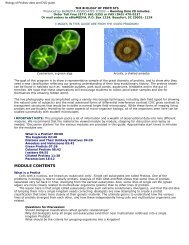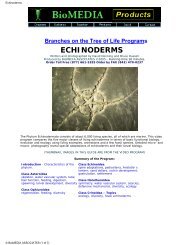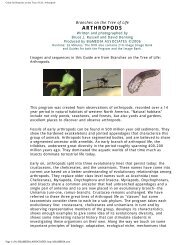Biology of chordates video guide.
Biology of chordates video guide.
Biology of chordates video guide.
You also want an ePaper? Increase the reach of your titles
YUMPU automatically turns print PDFs into web optimized ePapers that Google loves.
Branches on the Tree <strong>of</strong> Life DVD – CHORDATES<br />
Written and photographed by<br />
David Denning and Bruce Russell<br />
©2005, BioMEDIA ASSOCIATES<br />
(THUMBNAIL IMAGES IN THIS GUIDE ARE FROM THE DVD PROGRAM)<br />
.. ..<br />
To many students, the phylum Chordata doesn’t seem to make much sense. It contains such<br />
apparently disparate animals as tunicates (sea squirts), lancelets, fish and humans. This program<br />
explores the evolution, structure and classification <strong>of</strong> <strong>chordates</strong> with the main goal to clarify the unity<br />
<strong>of</strong> Phylum Chordata.<br />
All <strong>chordates</strong> possess four characteristics that define the phylum, although in most species, these<br />
characteristics can only be seen during a relatively small portion <strong>of</strong> the life cycle (and this is <strong>of</strong>ten an<br />
embryonic or larval stage, when the animal is difficult to observe). These defining characteristics are:<br />
the notochord (dorsal stiffening rod), a hollow dorsal nerve cord; pharyngeal gills; and a post anal tail<br />
that includes the notochord and nerve cord.<br />
Subphylum Urochordata<br />
The most primitive <strong>chordates</strong> are the tunicates or sea squirts, and closely related groups such as the<br />
larvaceans (Appendicularians). In tunicates, the chordate characteristics can be observed only by<br />
examining the entire life cycle. The adult feeds using a ‘pharyngeal basket’, a type <strong>of</strong> pharyngeal gill<br />
formed into a mesh-like basket. Cilia on the gill draw water into the mouth, through the basket mesh<br />
and out the excurrent siphon. Tunicates have an unusual heart which pumps by ‘wringing out’. It also<br />
reverses direction periodically. Tunicates are usually hermaphroditic, <strong>of</strong>ten casting eggs and sperm<br />
directly into the sea. After fertilization, the zygote develops into a ‘tadpole larva’. This swimming larva<br />
shows the remaining three chordate characters - notochord, dorsal nerve cord and post-anal tail.<br />
Tunicates show three general life styles: solitary, social (where individuals formed by asexual budding<br />
remain connected in a communal group); and ‘compound’ where individuals that develop by budding<br />
cluster around a common excurrent siphon.<br />
.. ..
p2.<br />
A related group, the<br />
larvaceans<br />
(Appendicularians), live<br />
throughout the life cycle as<br />
part <strong>of</strong> the oceanic<br />
plankton. These animals<br />
resemble tunicate tadpole<br />
larvae. Several hypotheses<br />
have been put forth<br />
regarding the origins <strong>of</strong><br />
the Phylum Chordata.<br />
Recent finds in early<br />
Cambrian Chinese fossil<br />
beds, have discovered<br />
fossil tunicates at least<br />
540 million years old.<br />
A popular hypothesis regarding chordate evolution<br />
suggests that an ancestral tunicate gave rise to the<br />
higher chordate groups through an evolutionary<br />
process (paedomorphosis) whereby structural and<br />
swimming characteristics <strong>of</strong> the tunicate tadpole larva<br />
were retained into adulthood. Through this process,<br />
the tunicate ancestral line was thought to have<br />
evolved into the larger swimming <strong>chordates</strong>. Modern<br />
molecular genetics evidence supports a different<br />
hypothesis -- that ancestral larvaceans are the<br />
ancestors probably to both tunicates and higher<br />
<strong>chordates</strong>.<br />
Subphylum Cephalordata<br />
By about 520 million years ago, a more advanced group <strong>of</strong> <strong>chordates</strong> were swimming the ancient seas,<br />
as shown by fossils found in Canada’s Burgess Shales. The ancient swimming chordate, Pikaia, was a<br />
member <strong>of</strong> Subphylum Cephalochordata, the group containing modern animals known as lancelets.<br />
Lancelets, (also known by their former name, ‘amphioxus’), such as Branchiostoma (‘gill - mouth’),<br />
live in shallow tropical sandy-bottom environments. They stick their heads out <strong>of</strong> the sand and feed<br />
somewhat like a tunicate. Cilia-driven currents ‘suck’ water into the mouth and across the pharyngeal<br />
gills. The lancelet has a strong supportive notochord, and angled muscles along the body used for brief<br />
periods <strong>of</strong> swimming, such as when the animal is dislodged from the sand.<br />
Subphylum Vertebrata<br />
One <strong>of</strong> the next groups <strong>of</strong> <strong>chordates</strong> to evolve was the jawless fish (Agnatha). Modern representatives<br />
<strong>of</strong> this group are the hagfishes and lampreys. Hagfishes are generally deep-water marine scavengers.<br />
They burrow into the mud, sticking their heads out until they detect waterborne odors <strong>of</strong> food such as<br />
decaying flesh. Then they travel along the odor gradient until they find their food, whereupon they use<br />
a rasping tongue to burrow into the flesh. When threatened or attacked, hagfish have the ability to<br />
secrete a skin-derived compound that immediately swells into a large ball <strong>of</strong> slime. This leads to their<br />
common name - slime-eels.<br />
Hagfish are clearly an evolutionary intermediate between lancelets and fish. Although better swimmers<br />
than lancelets, they lack the jaws, paired fins and gill covers <strong>of</strong> true fishes, having instead no jaws, a<br />
fin-like flap <strong>of</strong> skin along the body, and only simple pore openings for the gill chamber. The affinities<br />
between Cephalo<strong>chordates</strong> and the hagfish/lamprey group are most striking when viewing the larva <strong>of</strong><br />
the lamprey (ammocoetes larva). These larvae strongly resemble lancelets, with the addition <strong>of</strong> a<br />
pumping gill chamber. Although hagfish and lampreys do not have a segmented vertebral column, their<br />
notochord is somewhat calcified, and they are considered the most primitive members <strong>of</strong> the third<br />
major group <strong>of</strong> <strong>chordates</strong> - Subphylum Vertebrata.<br />
.. ..<br />
Over 400 million years ago the pace <strong>of</strong> chordate evolution picked up with the evolution <strong>of</strong> a variety <strong>of</strong><br />
groups <strong>of</strong> fishes. The major ancestral fish line first acquired paired fins. One descendant line acquired a<br />
cartilaginous skeleton leading to one <strong>of</strong> the most successful and ancient group <strong>of</strong> fishes, the sharks and<br />
rays. Another ancestral line developed calcified bones and ray-fins stiffened with spines. Contrary to<br />
the old idea that swim bladders gave rise to lungs--new evidence indicates exactly the opposite --<br />
‘primitive’ lungs evolved first as a supplement to ‘gill-breathing’. Thus, ancestral bony fish that gulped<br />
air gave rise to two lines <strong>of</strong> fishes.
p3.<br />
In one line <strong>of</strong> bony fish, the ‘ancestral lung’ became the swim<br />
bladder. This group, the Class Osteichthys, is the most<br />
successful modern group <strong>of</strong> fishes, with over 22,000 species<br />
found in virtually every aquatic habitat.<br />
Another major split in the bony fish line was much more<br />
successful in ancient seas than it is today. This ‘coelacanth’<br />
group (Class Crossopterygia), developed bones at the base <strong>of</strong><br />
its four stout ventral paired fins. These fish are also called the<br />
lobe-finned fishes.<br />
It is interesting to speculate how one line <strong>of</strong> ancient<br />
lobed-finned fishes evolved abilities to walk on land over time. This happened around 400 million years<br />
ago, when a combination <strong>of</strong> conditions allowed previously uninhabitable land to be colonized by plants,<br />
insects and other invertebrates. Key among these conditions was the diminishing intensity <strong>of</strong> ultraviolet<br />
light due to the developing ozone layer. Most likely, the invasion <strong>of</strong> land by <strong>chordates</strong> was linked, at<br />
least in part to the availability <strong>of</strong> prolific, essentially untapped, food resources (mostly insects).<br />
To speculate on chordate land invasion is one thing, but it is even more fascinating to observe a model<br />
for this process. Although not a coelacanth, the mudskipper provides an excellent model for the<br />
movement <strong>of</strong> <strong>chordates</strong> from water to land over 400 million years ago. Mudskippers live in mangrove<br />
swamps where they feed both in water and on the land. They move about by ‘walking’ with their<br />
pectoral and pelvic fins.<br />
...<br />
.. ..<br />
The invasion <strong>of</strong> land by <strong>chordates</strong> has been detailed significantly by recent fossil finds. One line <strong>of</strong><br />
lobe-finned fishes eventually developed good abilities to walk over land, and although these ancient<br />
land <strong>chordates</strong> began with 8 digits on their feet, their line eventually led to the 5-toed, 4-legged<br />
tetrapod ancestor to all modern land vertebrates. This ancestral line split into several groups. One<br />
group, the Amphibians retained more ancestral features including the dependence on water to<br />
complete their reproductive cycles.<br />
Other groups were liberated from the water through the<br />
development <strong>of</strong> a fluid-filled package to hold the developing embryo<br />
- the egg. Of these ancestral groups, one that developed scales led<br />
to modern reptiles and to the dinosaurs. Although the dinosaurs are<br />
thought to have finally died out with the Cretaceous extinction <strong>of</strong> 65<br />
million years ago, evidence now clearly indicates that a group <strong>of</strong><br />
dinosaurs developed feathers and give rise to survivors <strong>of</strong> the<br />
Cretaceous extinction -- the birds.<br />
The earliest mammal-like reptiles also laid eggs. This ancestral<br />
group developed hair rather than scales, and eventually led to the<br />
mammals. The earliest mammals probably laid eggs in a pouch.<br />
This is the reproductive approach <strong>of</strong> the most primitive extant<br />
mammals, the Monotremes. The duck-billed platypus and the<br />
echidna are both restricted to the Australia region. The echidna egg is leathery. After it hatches, the<br />
developing larva remains in the pouch, feeding <strong>of</strong>f a patch that secretes milk - a primitive mammary<br />
gland.
p4.<br />
.. ..<br />
In another group, the Marsupials, young are born as worm-like larvae, after a short period <strong>of</strong><br />
embryonic development in an egg inside the mother’s reproductive system. The larva squirms into the<br />
mother’s pouch and attaches itself to a mammary. Their use <strong>of</strong> the marsupial pouch (marsupium)<br />
continues even after they have grown to active juveniles.<br />
A third group <strong>of</strong> mammals has been the most successful. In this<br />
group, the ancestral condition <strong>of</strong> development in the egg has been<br />
replaced by development in a womb. The mother nourishes the<br />
developing embryo, and removes its wastes, through an exchange<br />
organ, the placenta. Placental mammals are born at a relatively<br />
advanced degree <strong>of</strong> maturity, and they are by far the most diverse<br />
and successful group <strong>of</strong> mammals. Over evolutionary time,<br />
members <strong>of</strong> the group have also returned to the sea.<br />
As diverse as they<br />
may first seem, the <strong>chordates</strong> represent a unified<br />
monophyletic line <strong>of</strong> evolution on the animal portion <strong>of</strong><br />
the tree <strong>of</strong> life. Living <strong>chordates</strong>, such as sea squirts,<br />
larvaceans, lancelets, hagfish, sharks, bony fish,<br />
salamanders, turtles, snakes, birds, and mammals all<br />
reflect descent from a common ancestor with the four<br />
chordate characteristics: notochord, dorsal nerve cord,<br />
post anal tail and pharyngeal gill. As but one tiny<br />
branch on this section <strong>of</strong> the tree <strong>of</strong> life, we humans<br />
can appreciate the remarkable sequence <strong>of</strong><br />
evolutionary changes that produced the current<br />
diversity <strong>of</strong> <strong>chordates</strong> from our simple ancestor <strong>of</strong> over<br />
540 million years ago.Branches on the Tree <strong>of</strong> Life DVD<br />
Branches on the Tree <strong>of</strong> Life DVD - Chordates from BioMEDIA ASSOCIATES<br />
Order Toll Free (877) 661-5355 or FAX (843) 470-0237<br />
Or mail orders to eBioMEDIA, P.O. Box 1234, Beaufort, SC 29901–1234
Branches on the Tree <strong>of</strong> Life DVD - CHORDATES<br />
Questions<br />
1) What are the four main characteristics <strong>of</strong> the Phylum Chordata?<br />
2) How long ago did phylum Chordata get its start? What is the evidence for this?<br />
3) How are human beings related to the blob-like marine organisms known as sea squirts?<br />
4) What is a “tadpole larva”? What chordate characteristics does it show?<br />
5) Which class <strong>of</strong> <strong>chordates</strong> retains all <strong>of</strong> the four basic chordate characteristics in the adult<br />
form?<br />
6) An ancient animal called Pikaia was found as fossils in the Burgess Shales <strong>of</strong> Canada. In<br />
what ways does this animal resemble the living organisms known as lancelets?<br />
7) How is a “hagfish” different than a true fish? How is it similar?<br />
8) Describe three major developments in the evolution <strong>of</strong> fish.<br />
9) Why is the coelacanth considered a “living fossil”? What is significant about the fins <strong>of</strong><br />
ancient coelacanth relatives?<br />
10) Very few amphibians survive in deserts, but desert reptiles are common. Why?<br />
11) Biologists now believe that birds are the most recent large group (class-level) <strong>of</strong><br />
vertebrates to evolve. Discuss this idea in terms <strong>of</strong> the time frame <strong>of</strong> vertebrate evolution.<br />
12) Name five major groups (class level) <strong>of</strong> egg-laying vertebrates (at least some species in<br />
the group lay an egg). Name three with an amniotic egg.<br />
13) Are birds reptiles? Discuss this idea.<br />
14) The mammal line <strong>of</strong> evolution has been around for over 300 million years when it split<br />
<strong>of</strong>f from the other vertebrate lines. The “age <strong>of</strong> mammals” (when mammals became the most<br />
abundant, largest, and most diverse land vertebrates) started around 60 million years ago.<br />
How has this time lag been explained by the fossil record?





